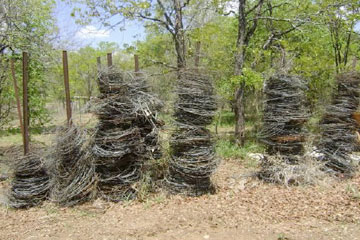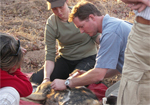Bushmeat hunting is one of the major threats to mammals in sub-Saharan Africa. Although widely discussed and recognized as an issues in Central and West Africa, a new study in mongabay.com’s open access journal Tropical Conservation Science describes a pattern of bushmeat hunting that is also occurring in southern Africa. Interviewing 114 locals living adjacent to Gonarezhou National Park in Zimbabwe, Edson Gandiwa with Wageningen University found that the primary drivers of illegal hunting in the park were bushmeat and personal consumption (68 percent).
“Although law enforcement patrols attempt to control illegal hunting, the expected economic benefits from the sale of bushmeat, derived from wild animals, are far greater than the costs associated with a low probability of arrest and punitive fines; thus illegal hunting is a persistent, widespread problem for animal species conservation,” writes the author.
A quarter of all respondents had seen bushmeat or wild animal parts being sold in their village in the last six months. Most stated that bushmeat was hunted “as a source of protein to alleviate poverty.”
 Wire snares confiscated in Zimbabwe. Photo by: Patience Gandiwa. |
Hunting was most often conducted with snares, while the use of dogs and bows-and-arrows came in second and third, respectively. Poisoning of big predators has also become a major issue.
“Poisoning, mostly using herbicides and pesticides, was reportedly used in revenge killings of large carnivores such as spotted hyenas and lions as a way to reduce livestock-carnivore conflicts,” the author writes, nothing that in one of the four villages surveyed, 38 percent of respondents listed poisoning as a hunting method. Overall 24 percent of respondents listed poisoning as a known method for hunting. S
Impala (Aepyceros melampus), kudu (Tragelaphus strepsiceros), Burchell’s zebra (Equus quagga), and African buffalo (Syncerus caffer) were the most popular targets of hunters. But 10 percent of respondents also reported the hunting of spotted hyenas (Crocuta crocuta), leopards (Panthera pardus), and lions (Panthera leo).
In order to stem illegal hunting the author recommends more law enforcement with follow-through on punishments, environmental education and awareness, and better methods to reduce revenge killing of carnivores, including considering supplying “bushmeat from legal sources to affected communities.”
CITATION: Gandiwa, E. 2011. Preliminary assessment of illegal hunting by communities adjacent to the northern Gonarezhou National Park, Zimbabwe. Tropical Conservation Science Vol. 4(4):445-467.
Related articles
Slaughtered elephant served up at Zimbabwean rally with president
(10/12/2010) On the menu at the most recent rally for the Zimbabwe African National Union Political Front (ZANU-PF): 3 African buffalo, 3 elephants, and a lot of smaller game according to SW Radio Africa. Attended by Zimbabwe’s President and founder of ZANU-PF, Robert Mugabe, the rally also celebrated the opening of the Women’s Celebration Bank.
UN official: Zimbabwe security forces poached 200 rhinos
(02/14/2010) Last week the secretary of the UN Convention on International Trade in Endangered Species (CITES), Willem Wijnstekers, announced that security forces in Zimbabwe had poached approximately 200 rhinos in a two year period. He did say how many elephants were poached by security forces.
Painted Dog population falls 99%, but community efforts could save species

(09/28/2008) The painted dog, or African wild dog, was once found widely across Africa but relentless persecution by humans, coupled with habitat loss and spread of disease from domestic dogs, has driven the population down from 500,000 to less than 5,000 over the past century. The species is now listed as endangered by the IUCN. While the outlook is not good in many countries, there are emerging signs of hope, particularly in Zimbabwe where the efforts of a community-based conservation project has nearly doubled the population of the dog to 700 individuals.